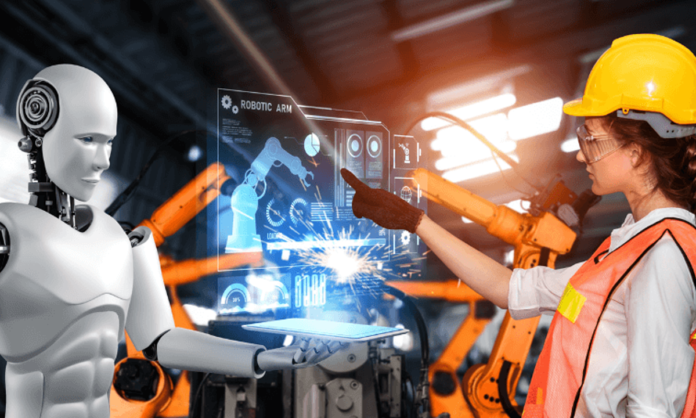Actually, Artificial Intelligence (AI) is no longer that shrouded concept mooted in science fiction with the transforming process in the business currently, but part and parcel of the boom and advancement in AI as it helps unveil new opportunities, creates room to improve operational efficiencies, decision-making processes, and experience a customer’s. Not the new adjustment of the bars but to stretch into what is possible using machines and technology, but the old disrupted sectors. Transformed, far from being tech-focused, very much affecting sectors in healthcare, finance, and manufacturing.
This paper examines the change that AI would bring to industries, the ongoing trends driving innovation in AI, along with examples, challenges, and opportunities for businesses embracing this transforming technology.
1. Artificial Intelligence (AI) Transformation in Industries
Transforming Business with AI
AI has now become the hub that rides the digital transformation wheel in nearly every industry. This potent one can transform every single line of manufacturing, customer service and everything in between, driven by core processes. AI has revolutionized the manufacturing sector with rationalizing the assembly lines and reducing scope for human errors. However, AI-driven robotics and automation comes way before schedule, yet predictive maintenance solutions lower failing machineries, hence, downtime reduces but seemingly saves cost in that time-wasting process.
AI goes a long way in health aspects with much more potential in diagnostics, personalized medicine, and drug development. It might be able to scan enormous data bases in real time and might even detect patterns that had slivered from human eyes of analysts. For example, imaging recognition tools. Those would be able to detect diseases much earlier for the human eye than it was possible earlier and at once with far higher accuracy than it was possible earlier. However, there are even more updates: individualized treatment therapy finds source from the targeted genetic profile; however, the healthcare service was even more efficient and patient-oriented.
It also transformed the financial services. This ability to automate the humdrum activities makes the transactions and fraud transactions quickest and safest. Also, AI enlightens many consumption behaviors. It made business houses personalize financial products that also meant never-before levels of satisfaction and loyalty received from the customers. The ability of AI to provide services immediately through the medium of chatbots and virtual assistants in banks wipe out human attendance of queries.
Of course, agriculture is perhaps one of the most conservative fields; it’s not going to remain untouched either by all these changes that AI is bound to introduce. That is known as precision farming: an industry that is trying to enhance crop yields by intelligent application through sensors and drones and by predictive analytics through the monitoring of a trend of weather. And measurement of health and moisture in the soil in such a way that the farmer is very well informed on decisions leading to efficiency and reduction in waste.
Automation Power
Automation is the most glaring take-home of AI. From the selection of answers for customer service chats to suggesting answers to the almost entirely data-related “automaton” process automation in logistics industries, AI increases productivity by substituting mundane work without thinking with strategic work that reflects a sense of higher general efficiency once more. Indeed, for instance, all general questions are washed off from the customer care agents so that they rub shoulders and intermingle even over the total needs of the customers.
More importantly, AI will empower the merchants and the retailers to offer appropriate kinds of products to their customers; therefore, rest assured that all conversion rates are fully utilized; hence the customers will feel a much more personalized experience. That is to say, the experiences will be personal to shops starting from their raw inventory management for making the retailers compete with the dynamic market.
2. Future Trends and Innovations
Future Trends and Innovations of AI
Among the future trends of AI innovation are deep learning further toward processing data in real time and pushing some of the boundaries that were actually mentioned above.
1. Integration of AI with 5G
New Avenues that Opened through 5G Networks. A massive processing that has to be done at an incredible speed unlocks the AI possibilities of 5G networks. It is only when you look backwards that possibilities unlock behind 5G in its applications like self-driving cars, smart cities, industrial automation etc, and practical efficiency achievable in a low latency speed would qualify the systems as operational much more efficiently thus paving the way for real time decision making and automation.
2. AI in Edge Computing
This approach to edge computing, wherein the process is nearest to the origin of data, has become much more indispensable lately by realizing that real-time data needs to be processed in fast time. AI can respond with lower delay and with lesser dependency on central cloud systems at the edge. This technology finds proper industrial application in manufacturing industries making use of real-time decisions on the factory floor for maximum efficiency in the production process. Thus, Edge AI emerges as one of the prime drivers in remote monitoring devices in the health sector where processing of real-time data becomes necessary in the care of a patient.
3. AI and Blockchain Integration
Although the term blockchain applies only to a cryptocurrency, the recent emerging trend is that the interface of the blockchain-AI. Blockchain can be correlated with AI to give a safe and decentralized data environment so that it safeguards the integrity and security of the data information. This interface is very convenient to the industries wherein, financially and health-wise, it becomes very vital that the data to be dealt with becomes pretty safe.
4. AI and Natural Language Processing (NLP)
NLP developments are actually empowering AI to digest and feel human speech at a very deep level. It is slowly penetrating customer support sectors with its potency through AI-based virtual assistants that can work on complex query-related jobs. These NLP algorithms can analyze large sets of data over texts in legal and medical industries to accelerate their research and discovery processes.
5. AI and Quantum Computing
Quantum computing is going to introduce a new dimension to AI far beyond, still in its infancy. Quantum computing is capable of performing calculations that are extremely complex at speeds way beyond what the present method can achieve, which might revolutionize AI, as it is possible that problems considered hitherto as unsolvable may find solution areas.
That is going to have huge ramifications on industries of cryptography, drug discovery, and financial modeling.
6. Ethical AI and Explainable AI (XAI)
The more it is put to real use, the more it opens up the need to discuss, if it’s time to be over with ethics in AI constructs. And thus at present, the corporations and the regulatory bodies are demanding for the algorithms for AI to be explainable in such a way that the decisions rendered by machines can be described as not biased and ethically apt. What is Explainable AI, or XAI? Now, if this happens in such sensitive areas as hiring or lending and health care, businesses would see why AI does that kind of decision-making-phenomenon that only entered the mainstream a few years ago.
3. Real-World Examples and Case Studies
Real-World Examples of AI in Industry
1. Healthcare: IBM Watson in Oncology
This is just too amazing how technology in the Watson of IBM can change the health sector, especially in oncology. These scan enormous amounts of information on medicine, highly likely to give a sharper insight that would allow a doctor to design a treatment plan for a patient with cancer. Watson scans clinical trials, patient files, and scientific studies so the decision by a physician is based on data, thus improving the outcome for the patient.
2. Retail: Amazon’s AI-Powered Recommendation Engine
The company struck it rich on the standard about customized retailing on its AI recommendation engine. Great example was that analytics on history of surfing, buying behavior and preferences of a user lead to an indication of such individualized products that could be sold to those very customers, creating sales and boosting customer satisfaction.
3. Production: Siemens Smart Factories
For the “smart factories” that Siemens established to run on their own without human intervention, Siemens needed AI and IoT. There, constantly running algorithms scanning the manufacturing process in real time for possible incidents of equipment failure that would lead to maximum operating efficiency interact with AI. Predictive maintenance brought sudden, tremendous declines by machines in idle times and in operation costs.
4. Finance: JPMorgan Contract Intelligence
For instance, in AI, JPMorgan can read thousands of legal documents because points of information automatically give meaning. To this extent, therefore, is JPMorgan embracing AI, and reviewing the legal document becomes smooth without errors and wrong impression created from reading the document.
4. Challenges and Opportunities
Challenges and Opportunities in AI Adoption
1. Data Privacy and Security
And in such AI that has to be based on mammoth data sets, then it really becomes a challenge in the aspects of data security and privacy. This forces companies to work under stricter regulations like the GDPR, and ensure that the AI never violates one’s user’s privacy. So, companies also get the chance of designing an AI that is highly powerful yet secure and non-violative of its users’ privacy.
2. Skill Gap
Now, another gap that is emerging relates to the day-to-day knowledge gap in AI skills. Only a few experts in the companies can design and control the AI system since most of the companies wish to begin using AI.
This will be a free open invitation for schools and companies to invest in AI training programs as a spark plug equipping the workforce with the needed expertise.
3. Ethical AI
Major issues that emerge with AI include job displacement, algorithmic bias, and the lack of transparency in AI decisions. These are extremely critical because firms must catch up with ethical practice in AI as they try to win public confidence and avoid pitfalls of regulations.
4. Interoperability with other systems
Most of the firms will now hardwire AI into their archaic and incompatible infrastructures. This hence presents opportunities to service companies specializing in AI.
Conclusion and Recommendations
Indeed, it has to unlock new industries with unprecedented growth opportunities against unprecedented efficiency and growth. Be it health care or finance or manufacturing or retail-the business landscape changes when AI comes; it unlocks new possibilities and drives industries. But its business potential could have only been fully realized if data privacy, skills gaps, and integration issues within legacy systems had been solved.
AI adoption lessons for the firms: incremental steps in domains where AI can deliver near-term value and then scale up as the needed infrastructure and expertise are built. Now that’s a bright future with AI. And so who would best be placed to lead in this digital age?
Actionable recommendations
1.Talent development investment and that will fill in the gaps of skill
2. Ethical AI and transparency will bring about trust
3. Strong measures on data protection and security.
4. Nano-prototypes to scale up projects
AI will be in the drift of making disruptions with further reading industries because those business needs to be ahead of the curve by embracing new ways of AI technologies for the benefits of long-term objectives.













